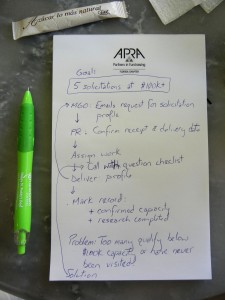 I am thrilled to share a guest post from Gil Israeli, Director of Prospect Research and Senior Writer for the American Technion Society.
I am thrilled to share a guest post from Gil Israeli, Director of Prospect Research and Senior Writer for the American Technion Society.
Let’s say you’re a front-line fundraiser and your organization is providing a prospect researcher to support your work. If you’re new to this professional collaboration, what should you look for when you’re interviewing candidates?
Optimism
Every fundraiser knows that an ongoing normal part of their business involves rejection – rejection by prospective donors. Initially, most researchers are unaware of the challenges faced by fundraisers (be they professionals or volunteers). In an earlier position, one grant-seeking professor soberly told me that his (better-than-average) rate of success was one funded proposal for every five that he submitted to government agencies.
It takes an incredible level of optimism to be a fundraiser and this also applies to the researcher who is one degree removed from direct contact with the prospect. Sometimes an inexperienced researcher has limited contact with the fundraisers. This type of isolation can make it challenging to keep abreast of the broader issues which affect the organization. A good dose of optimism may be the most important trait in a good researcher. It starts the researcher on a solid path to acquiring essential skills and supports him or her in the next career activity: branching out into their organization to know its people and learn its processes.
Curiosity
There are three types of knowledge that are critical to a researcher’s success: knowledge of research methods and data; knowledge of one’s organization and its projects; and knowledge of the overall fundraising process and the actual industry. The best researchers go well beyond the first realm.
Not only do they know how to “drill down” deep to find a level of data that provides a detailed research-based story of the prospect, they need to make connections for the fundraiser that will apply the data to his cultivation efforts. This requires that the researcher understand how the fundraiser strategizes and even interacts with prospects. It also requires organizational knowledge, e.g., in a university operation (and most others), a capital project requires a cash gift to break ground. This information would figure into your analysis of a prospect’s liquidity for a capital gift. A researcher needs to have genuine curiosity that extends beyond the mere data.
Understanding all aspects of the organization’s work enables the researcher to prepare actionable research for the fundraiser. Having a second set of eyes – “fundraiser eyes” – enables the researcher to envision how a prospect’s data may ideally fit into the mission of the organization.
Good interpersonal skills also come into play which aid the researcher as he or she gets to know one’s colleagues and the rich world of fundraising practices, policies and prospect interactions.
Perseverance
Perseverance, the high-octane extension of curiosity and another critical characteristic, is going the extra distance in your work in the most calculated way. It is fueled by curiosity and the knowledge it brings. And perseverance is exhibited best in the type of research reports that researchers produce.
Today, generally, you’ll find two types of prospect reports. One, via the profile template, is organized in sections, which is particularly useful for exporting data from your database. However, it may lack certain types of information which can only be expressed in anecdotal reports of actionable information. This type of information comes out especially in the narrative report and can appear in a database’s open text field. You can also generate a final product that combines these two types of reports. So, what are the benefits of this?
I recently reported on a Boston-based technology magnate. My own position supports a major university with interests in science, technology, medicine, engineering and education programs. As the president of the university was to meet with this individual, I prepared a hybrid report which combined the template (with an estimated capacity rating, assets, boards, etc.) and additional, necessary, narrative sections. These required “insider knowledge,” which I had developed through 13 years of experience with the organization.
In the narrative parts, I was able to draw inferences and connect relevant information such as the prospect’s boards and past gifts to the immediate interests and current project needs of the university. For example, the prospect was critically involved in developing a national database to record comprehensive data about students in U.S. public school systems. Accordingly, I was able to discuss and recommend technology infrastructure projects that would enhance the university’s services to all students and also library projects that would serve the entire university community. The report helped the president strategize at a much higher level before even meeting the prospect. This type of “added-value” research requires real perseverance as it requires that the researcher maintain the most up-to-date knowledge of your organization’s work and the provision that you productively integrate it into your research reports.
Gaining Insight to Know When You’re Off-Target
Over time, perseverance will also bring the researcher experience to better evaluate the “cash value” of his or her own work. It’s also important to be able to recognize when research doesn’t meet the test of practicality. On one occasion, I identified a family that owned a lucrative multigenerational business with several dozen restaurants on the east coast. After my excitement peaked, I noted that their corporate headquarters and residences were located in a locale that made fundraiser visits exorbitantly expensive when compared with our usual visits to prospects. Even more so, allocating funds for these visits would have diverted the monies from other good uses, e.g., special events where several major gift prospects could be gathered and engaged. In this case, my knowledge of the fundraising operation (a business perspective) also helped me determine that this proactive research was simply not practical and actionable. I had gained this knowledge over years as I became involved in additional meetings and had the opportunity to converse more with my fundraiser colleagues. And it made me better at my job.
Creativity
Prospect research reports can become homogeneous and suffer the problem of omission when we allow ourselves to be limited by our tools. For example, researchers need a reasonable level of comfort with numbers and formula to effectively calculate capacity ranges and ratings. Most of these measures of prospect capacity are then augmented with advanced knowledge that we have gained by analyzing other types of assets such as the value of private companies, pensions, collections, etc. Again, curiosity comes into play and in multiple ways.
Because each prospect is unique, each prospect research report may also need to be unique and require its own creative approach. Creativity turns out to be the critical characteristic for the researcher who can adapt to different prospect types. Learn the rules and then break them at the right time in a practical way for insightful returns.
Conclusion
We all know the litany: computer-writing-communication-analytical skills are essential to high performance in nearly all of today’s urban-based information-processing desk jobs.
I’ve focused on strong optimism, expansive curiosity, unflagging perseverance and practical creativity because they are often not given the explicit attention that they should receive when hiring a prospect researcher. A really good prospect researcher has these characteristics with the skill sets we expect and a social aptitude for connecting with fundraising colleagues. Without these characteristics, he or she remains tied to the first literal level of discovered data and is unable to further contextualize it for strategic use for his or her fundraiser colleagues.
The best news is that when the sparks of these four qualities exist, they can be nurtured with one’s colleagues for mutual professional development and fruitful collaboration. Finally, these qualities are akin to sustainable energy: they can keep the prospect researcher growing throughout his or her career.
About the Author
 Gil Israeli serves as the Director of Prospect Research and Senior Writer for the American Technion Society, which supports the Technion, Israel’s premier university advancing science, technology and medicine. He holds degrees from Johns Hopkins, Columbia University and the University of Virginia. He edits fundraisingcompass.com , a blog which presents pieces by seasoned fundraising professionals.
Gil Israeli serves as the Director of Prospect Research and Senior Writer for the American Technion Society, which supports the Technion, Israel’s premier university advancing science, technology and medicine. He holds degrees from Johns Hopkins, Columbia University and the University of Virginia. He edits fundraisingcompass.com , a blog which presents pieces by seasoned fundraising professionals.
 This past weekend I sat down and listened to frontline fundraisers and prospect researchers talk about how they work efficiently and respectfully to raise money in China. It felt long on a Saturday afternoon, but it was worth every minute. If you can find a viewing, go watch it!
This past weekend I sat down and listened to frontline fundraisers and prospect researchers talk about how they work efficiently and respectfully to raise money in China. It felt long on a Saturday afternoon, but it was worth every minute. If you can find a viewing, go watch it!









